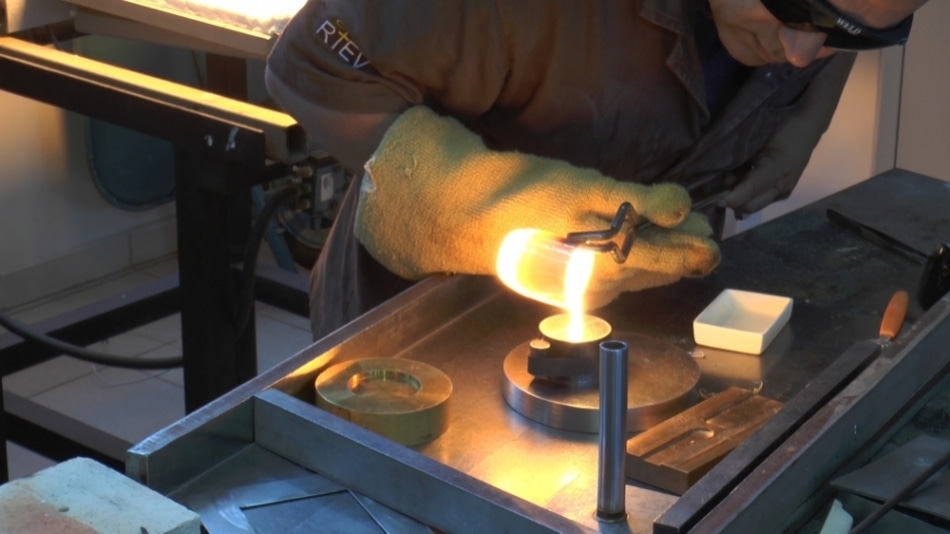Jul 11 2019
Researchers have developed a unique theoretical model that gives a more improved description of crystallization in glass particles and one that can also be used for estimating its speed.
 A study by researchers affiliated with a research center supported by FAPESP can help scientists develop new glass and glass-ceramic materials and predict glass stability during use (Image credit: Agência FAPESP)
A study by researchers affiliated with a research center supported by FAPESP can help scientists develop new glass and glass-ceramic materials and predict glass stability during use (Image credit: Agência FAPESP)
The research team was affiliated with the Center for Research, Technology, and Education in Vitreous Materials (CeRTEV), hosted by the Federal University of São Carlos (UFSCar) in São Paulo State, Brazil.
The study, reported in Acta Materialia, can be used for developing innovative glass-ceramic materials and determining glass stability during use. This latest development would help, for instance, to prevent the uncontrolled crystallization and sudden breakage of the glass door of a kitchen oven while heating up.
Crystallization is an important factor in the manufacture of glass and glass-ceramics, explained Edgar Dutra Zanotto, a professor at Universidade Federal de São Carlos (UFSCar) and Director of CeRTEV.
It’s important to understand crystallization in glass production so that it can be avoided and the material can become rigid without crystallizing. On the other hand, crystallization can be induced and controlled in special glasses by means of heat treatment. This is the case when producing glass-ceramic materials, which are partially crystallized.
Edgar Dutra Zanotto, Professor at UFSCar and Director of CeRTEV
With controlled crystallization of glass-ceramics, microstructures can be produced easily. These microstructures would have certain properties, including high resistance, for use in a wide range of applications, such as artificial teeth, substrates for PC hard disks, telescope mirrors, and cooktops.
The American Ceramic Society (ACerS) recognized the study with a Spriggs Phase Equilibria Award for the most useful contribution to phase stability associations in ceramic-based systems literature during the year. In materials science and engineering, phase stability is considered a major phenomenon.
The award will be given to Zanotto at the 121st Annual Meeting of AcerS in Portland, Oregon (USA) in September, 2019.
Raphael Reis, a PhD in materials engineering from UFSCar and presently a professor at Universidade Federal Fluminense (UFF), was also involved in the development of the novel model.
“Our academic research group at CeRTEV is one of the five largest in the world in glass. Nucleation and crystallization are among the topics we’ve studied,” Zanotto stated in a presentation to the first symposium on research and innovation in functional materials conducted on May 23rd to 24th, 2019, at UFSCar. The symposium was held by the Center for Development of Functional Materials (CDMF).
CeRTEV and CDMF are Research, Innovation, and Dissemination Centers (RIDCs) financed by FAPESP.
Zanotto informed that crystallization starts when crystals are nucleated on the surface or in the interior of glass particles when a material is heated to an elevated temperature for a certain period.
The original hypothetical models of this phenomenon were created six decades ago. Among these, one particular model suggested that cube-shaped crystals grow at fixed spatial intervals on the glass particle surface, and that crystals are capable of growing only toward the center of the particle as soon as a fully crystalline surface is created.
Zanotto explained that while these models continue to be significant, they are also mathematically complicated and need solutions based on computational techniques that render them difficult to use. In order overcome these problems, the team created a unique model that describes crystallization in non-isothermal conditions (that is, with fluctuations in temperature) from nucleation sites in the interior or on the surface of glass particles.
Our model is based on a very simple equation, greatly facilitating its use and the interpretation of the results. It very accurately describes crystallization in nonisothermal conditions.
Edgar Dutra Zanotto, Professor at UFSCar and Director of CeRTEV
The novel crystallization model was tested by the researchers to assess crystallization from a limited number of nuclei present on the surface of diopside (calcium magnesium silicate) glass particles and concurrently on the inside and surface of lithium disilicate glass particles.
The researchers employed a method known as differential scanning calorimetry, which detects the temperatures of glass transition and crystallization. Subsequently, they compared the outcomes of the latest model against those of the older and more intricate models based on three parameters—non-dimensional time, the number of internal nuclei, and the number of surface nuclei.
The comparisons demonstrated that although the analytical equation of the new model is relatively simpler, it generated analogous outcomes to those of the intricate models.
The researchers also informed that the new model created a more accurate approximation for particles that sinter (compact into a solid mass by heat without melting) at the time of phase transformation, for example, glass particles that crystallize concurrently during sintering.
The latest model can also be used for predicting transformations, beginning from grain boundaries in polycrystalline materials, for example, glass-ceramics.
Theoretical models like the one we’ve developed are important because they help us understand phenomena and make predictions without the need to perform experiments.
Edgar Dutra Zanotto, Professor at UFSCar and Director of CeRTEV
The article, published in Acta Materialia, is titled “Simple model for particle phase transformation kinetics.”